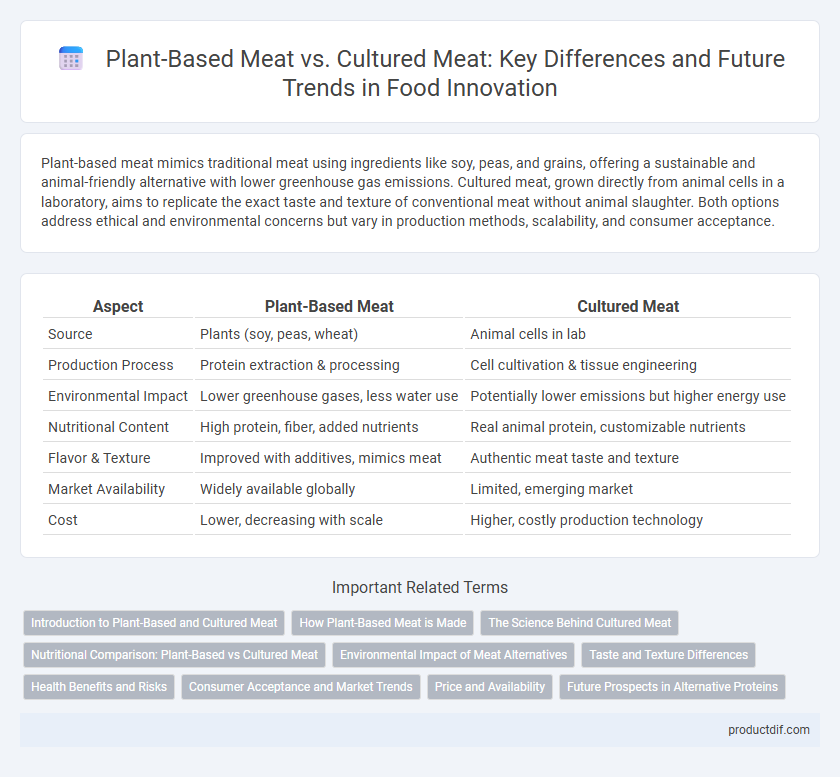Plant-based meat mimics traditional meat using ingredients like soy, peas, and grains, offering a sustainable and animal-friendly alternative with lower greenhouse gas emissions. Cultured meat, grown directly from animal cells in a laboratory, aims to replicate the exact taste and texture of conventional meat without animal slaughter. Both options address ethical and environmental concerns but vary in production methods, scalability, and consumer acceptance.
Table of Comparison
| Aspect | Plant-Based Meat | Cultured Meat |
|---|---|---|
| Source | Plants (soy, peas, wheat) | Animal cells in lab |
| Production Process | Protein extraction & processing | Cell cultivation & tissue engineering |
| Environmental Impact | Lower greenhouse gases, less water use | Potentially lower emissions but higher energy use |
| Nutritional Content | High protein, fiber, added nutrients | Real animal protein, customizable nutrients |
| Flavor & Texture | Improved with additives, mimics meat | Authentic meat taste and texture |
| Market Availability | Widely available globally | Limited, emerging market |
| Cost | Lower, decreasing with scale | Higher, costly production technology |
Introduction to Plant-Based and Cultured Meat
Plant-based meat is derived from vegetables, legumes, and grains engineered to mimic the taste, texture, and nutritional profile of animal meat, offering a sustainable alternative to traditional livestock. Cultured meat, also known as lab-grown or cell-based meat, is produced by cultivating animal cells directly, eliminating the need for raising and slaughtering animals. Both technologies aim to address environmental concerns, animal welfare, and food security while providing consumers with meat options that reduce the ecological footprint.
How Plant-Based Meat is Made
Plant-based meat is produced by combining proteins from sources such as soy, peas, or wheat with fats, binders, and flavorings to replicate the texture and taste of animal meat. The production process often involves extrusion cooking, where the plant proteins are heated and transformed to create a fibrous, meat-like structure. This method enables the creation of products like burgers, sausages, and nuggets that appeal to consumers seeking sustainable and cruelty-free alternatives.
The Science Behind Cultured Meat
Cultured meat is produced by cultivating animal cells directly in a controlled environment, bypassing the need to raise and slaughter animals. This biotechnological process relies on stem cells harvested from a small biopsy, which are then multiplied and differentiated into muscle tissue using growth media rich in nutrients and growth factors. Advances in tissue engineering and bioreactor design continue to improve scalability, texture, and flavor, making cultured meat a promising alternative to traditional and plant-based meat products.
Nutritional Comparison: Plant-Based vs Cultured Meat
Plant-based meat products typically contain higher fiber content and are lower in saturated fats compared to cultured meat, which more closely replicates the complete protein profile and micronutrient density of traditional animal meat. Cultured meat offers a balanced amino acid profile and essential vitamins like B12, often lacking or added artificially in plant-based alternatives. Nutritional optimization in cultured meat aims to match or exceed the bioavailability of nutrients found in conventional meat, making it a promising protein source for health-conscious consumers.
Environmental Impact of Meat Alternatives
Plant-based meat produces significantly fewer greenhouse gas emissions, requiring less land and water compared to traditional animal farming, thereby reducing deforestation and biodiversity loss. Cultured meat, grown from animal cells in bioreactors, offers the potential to further decrease methane emissions and resource use but currently demands high energy inputs that challenge its sustainability. Advances in renewable energy integration and bioprocess efficiency are critical to ensuring cultured meat becomes a viable, low-impact alternative in the global food system.
Taste and Texture Differences
Plant-based meat mimics traditional meat's fibrous texture using ingredients like pea protein and soy, often resulting in a slightly grainier consistency, whereas cultured meat offers an authentic muscle cell structure that closely replicates the tender juiciness of real animal meat. Flavor profiles differ as plant-based meats rely on added flavorings and spices to simulate umami, while cultured meat naturally develops the complex taste from actual muscle tissue. Consumers often describe cultured meat as having a more convincing mouthfeel and savory depth, making it a preferred option for those seeking a true meat experience without animal slaughter.
Health Benefits and Risks
Plant-based meat offers lower saturated fat and no cholesterol, supporting heart health and reducing risks of cardiovascular diseases. Cultured meat provides complete proteins with fewer antibiotics and lower risk of contamination compared to conventional meat, but potential unknown long-term health effects remain under study. Both alternatives reduce exposure to pathogens found in traditional meat but require further research to fully understand their impacts on human health.
Consumer Acceptance and Market Trends
Consumer acceptance of plant-based meat remains strong due to its affordability, familiarity, and environmental benefits, while cultured meat faces challenges related to higher costs and regulatory hurdles. Market trends indicate rapid growth in plant-based meat sales driven by innovations in taste and texture, whereas cultured meat is anticipated to expand as production scales and prices decrease. Surveys reveal growing interest in cultured meat among younger demographics, suggesting potential shifts in future consumer preferences.
Price and Availability
Plant-based meat products are generally more affordable and widely available in supermarkets and restaurants due to established production processes and supply chains. Cultured meat remains expensive, with prices often much higher because of complex bioreactor technologies and limited commercial scale. Availability of cultured meat is currently restricted to select markets and pilot programs, awaiting mass production advancements to improve accessibility.
Future Prospects in Alternative Proteins
Plant-based meat and cultured meat are revolutionizing the alternative protein market by offering sustainable and ethical solutions to traditional livestock farming. Advances in biotechnology and food science are driving cost reductions, improved taste, and texture profiles, making these products increasingly accessible and appealing to consumers worldwide. Market projections estimate the global alternative protein industry will exceed $140 billion by 2030, highlighting significant growth potential driven by environmental concerns and shifting dietary preferences.
plant-based meat vs cultured meat Infographic

 productdif.com
productdif.com